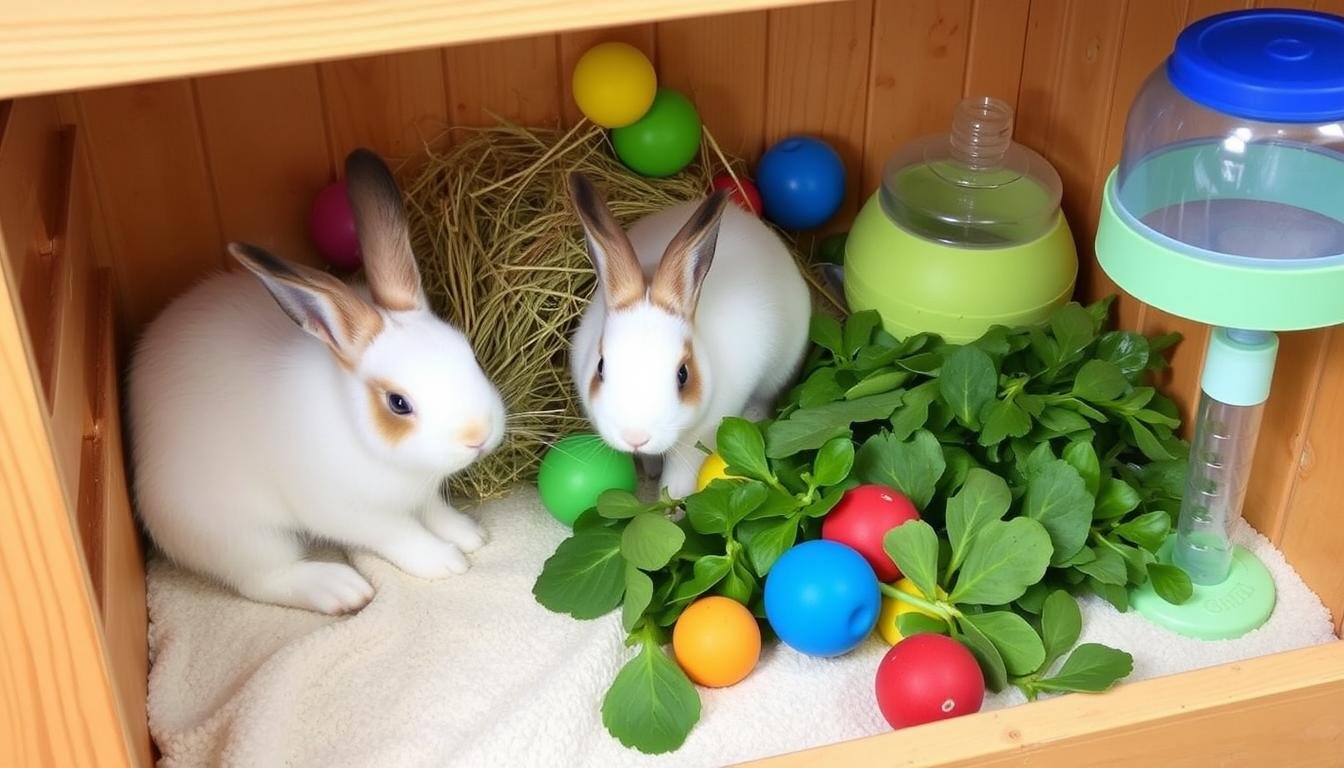Rabbits are becoming more popular as pets, but many new owners may not be ready. This guide will give you key rabbit care tips for new owners. It covers diet, housing, health, and safety. Follow these tips to make sure your rabbit is happy and healthy.
Rabbits can live up to 10 years or more. This shows the big commitment needed by potential rabbit owners. Also, spaying or neutering a rabbit can make their life longer and healthier. It reduces cancer and urinary tract infection risks. So, proper rabbit care is crucial for their well-being.
One key part of caring for a rabbit is a balanced diet. Rabbits need 25% forage for a healthy life. A good diet includes 80% grass hay, like timothy hay, for digestion and teeth health. Also, give them fresh leafy green veggies daily, one to five cups, based on their weight.
Importance of a Rabbit-Savvy Veterinarian
Rabbits need special care that’s different from dogs and cats. It’s key to find a vet who knows how to treat rabbits. This ensures your pet gets the best care for their health.
Finding an Experienced Vet
Finding a good rabbit vet takes some effort. Ask friends who have rabbits, local rescues, or breeders for tips. Look for vets with training in exotic animals. They know how to handle your rabbit’s unique needs.
Discussing Emergency Plans and First Aid
It’s important to talk about emergency plans with your vet. Rabbits can get sick easily, from stomach problems to breathing infections. Knowing what to do in an emergency and having a first aid kit can save your rabbit’s life. Your vet can show you how to make a kit and teach you about common health issues and first aid.
| Rabbit Emergency Supplies | Importance |
|---|---|
| Syringes and needles | For administering medications or fluids in an emergency |
| Simethicone (Gas Relief) | Helps alleviate gastrointestinal issues like bloat |
| Styptic powder | Stops bleeding from minor cuts or nail trimming |
| Sterile saline solution | For flushing wounds or cleaning the eyes |
| Bandages and gauze | For dressing wounds and injuries |
Spaying and Neutering Benefits
Spaying and neutering rabbits is key for responsible pet care. It stops unwanted litters and boosts health and behavior. Unspayed female rabbits face an 85% chance of reproductive cancer. Neutering male rabbits, especially between 3 to 6 months, greatly improves their health.
Preventing Unwanted Litters
Rabbits breed fast, with a pair producing up to 12 litters a year. Each litter has 1 to 12 kits. This leads to millions of rabbits being euthanized in shelters. Spaying and neutering stops these litters, ensuring rabbits find loving homes.
Reducing Behavioral Issues and Health Risks
Spaying and neutering changes rabbit behavior and health. Altered rabbits are calmer and more loving. They also avoid destructive behaviors like biting and territorial marking. Spaying female rabbits also prevents uterine cancer, a risk for up to 65% of unaltered females by age 4.
| Procedure | Benefits |
|---|---|
| Spaying (Females) |
|
| Neutering (Males) |
|
Spaying and neutering rabbits is safe when done by a skilled vet. It ensures your rabbit’s health and happiness. It also helps the rabbit community as a whole.
Rabbit Housing and Environment

Creating the right home for a rabbit is key to their happiness. For indoor homes, experts say a space of 3m x 2m and 1m high is best for two medium rabbits. This size lets them move, exercise, and act naturally. Also, giving them time to play outside is great for their health.
Appropriate Indoor Housing
The home should be made of safe, chew-resistant materials. It should have smooth edges to avoid injuries. Rabbits need places to hide, with as many spots as there are rabbits plus one extra.
Shelters above the ground keep predators away. Use strong wire mesh for safety. Bedding should be warm and safe, like straw or hay. Clean the home daily and do a full clean once a week to keep rabbits healthy.
Bunny-Proofing Your Home
When rabbits roam free, make sure your home is safe. Cover cords and remove harmful plants. Create a fun space for them to explore.
Rabbits are curious and love to chew. So, remove dangers and give them toys and places to climb. They enjoy digging in sand pits and hiding in boxes. Rabbits are most active in the morning, late afternoon, and at night. So, plan their free time carefully. With the right setup, your rabbit will be happy and healthy.
| Recommended Indoor Rabbit Enclosure Size | Optimal Bedding Material | Enclosure Cleaning Frequency |
|---|---|---|
| Minimum 3m x 2m and 1m high for two medium-sized rabbits | Dust-free straw or hay | Toilet area cleaned daily, full enclosure cleaned around once a week |
Litter Training and Enrichment
Setting up a proper litter box and training are key in rabbit care. Rabbits can learn to use a litter box, keeping your home clean and your rabbit happy. Hay, which makes up 85% of their diet, helps them use the litter box well.
Litter Box Setup and Training
It’s best to change a rabbit’s litter box every two to three days for cleanliness. For bonded bunnies, changing it every other day is better. Bunny litter is biodegradable, perfect for compost.
Older rabbits are easier to train than younger ones, especially babies. Rabbits may not always use the litter box perfectly. They mark their territory by dropping poop pellets in their cage.
Unfixed rabbits may become territorial after puberty, leading to bad litter habits. Spaying or neutering can help with proper litter habits. Changes in environment, stress, or health issues can also affect a rabbit’s litter habits.
A rabbit with sudden changes in litter habits might have a urinary tract infection. For a small home, one litter box is enough. But larger homes or multi-story locations might need more.
Providing Toys and Play Time
Engaging toys and regular playtime are vital for a rabbit’s happiness and health. It prevents boredom and encourages natural behaviors like digging and chewing. Offering different toys, like chew toys and tunnels, keeps their curiosity alive.
Playtime outside their cage lets rabbits stretch and exercise. It also strengthens the bond between you and your rabbit. This time is crucial for their well-being and your relationship.
Rabbit care tips for new owners
Caring for a rabbit can be rewarding but also comes with challenges. As a new owner, learning about rabbit care is key. Here are some important tips to remember:
- Find a vet who knows rabbits well. Regular vet visits and care are vital for your rabbit’s health.
- Spay or neuter your rabbit. This stops unwanted litters and helps with behavior and health issues.
- Give your rabbit a big, safe space. They need lots of room, the right housing, toys, and space to move.
- Feed a diet rich in hay. Hay should be the main food, with fresh greens and a few treats.
- Keep your rabbit busy with fun activities. Litter training, play, and toys prevent boredom and encourage natural behavior.
- Make your home safe for your rabbit. Secure wires, remove dangers, and create a chew-proof area for them.
By following these rabbit care tips for new owners, you’ll be on the right path. With patience, dedication, and the right knowledge, you can give your rabbit a happy, healthy home.
Proper Rabbit Diet

Keeping your pet rabbit healthy starts with a good diet. Hay should make up about 85% of their food. It’s key for their digestion and teeth. They also need fresh, leafy greens for nutrients and fiber.
Importance of Hay and Fresh Greens
Hay is always available for rabbits. It helps their teeth grow and keeps their digestive system healthy. Timothy hay or orchard grass hay are great options. Daily, give them a big handful of greens like spinach, kale, and parsley. These greens are full of vitamins and minerals.
Healthy Treats and Foods to Avoid
- Pellets or nuggets can be given in small, measured amounts, with growing, pregnant, or nursing rabbits requiring slightly larger portions.
- Occasional treats like carrots and apples should be limited, as they are high in sugar and can lead to digestive issues if consumed in excess.
- Processed human foods, such as chocolate and cereals, are dangerous for rabbits and should be strictly avoided.
Watch your rabbit’s diet and droppings closely. Any changes could mean health issues. A balanced diet of hay, greens, and a few treats keeps your rabbit happy and healthy.
Handling and Interacting with Your Rabbit
Building a strong bond with your rabbit starts with proper handling and interaction. It’s key to understand their unique anatomy and behavior. This helps avoid stress or harm to them.
Rabbits have a delicate skeleton, making up only 7-8% of their body weight. This is less than cats and humans. So, they need gentle handling to prevent injury. Scruffing, or picking them up by the neck, should be avoided as it’s uncomfortable and can mimic predators.
Instead, lift and hold rabbits by supporting their hindquarters and chest. This creates a secure grip that’s comfortable for them. Also, avoid “trancing” your rabbit, as it can cause dangerous drops in their heart rate and blood pressure.
- Approach your rabbit calmly and confidently to establish trust and reduce their stress levels.
- Use gentle, secure grips when lifting and holding your rabbit, supporting their entire body.
- Avoid scruffing or trancing your rabbit, as these techniques can be harmful and cause unnecessary distress.
Engaging in positive reinforcement training and social activities can strengthen your bond. Rabbits are social and enjoy daily interaction. Spend time playing, cuddling, and rewarding good behavior with treats and affection.
Rabbits may show challenging behaviors like running away or biting when handled. This is often due to the handler’s energy and confidence. With patience and proper training, you can handle your rabbit with ease and build a loving relationship.
Rabbit-Proofing and Safety
Rabbit owners need to take steps to keep their homes safe for their pets. Rabbits are curious and love to chew on things like electrical cords and carpets. This can be very dangerous for them. By removing hazards, you can keep your rabbit safe and healthy.
Covering Cords and Removing Hazards
Electrical cords are a big risk for rabbits. To keep them safe, cover these cords with spiral wraps. This simple step can save your rabbit’s life and avoid expensive damage to your home.
It’s also important to get rid of toxic plants and block off dangerous spots. Replace carpets with safer options like vinyl or outdoor carpeting. These choices are better for rabbits and easier to clean.
Proper rabbit-proofing can make a big difference. It helps ensure your rabbit stays happy and safe. By identifying and fixing hazards, you create a great space for your rabbit to enjoy.
Conclusion
Bringing a rabbit into your home can be very rewarding. But, it also comes with big responsibilities. By following the tips in this article, you can make sure your rabbit gets the care they need.
This includes the right food, a safe place to live, vet visits, and fun activities. Taking care of a rabbit is a big commitment. But, with the right effort, you can give your rabbit a happy home.
Caring for a rabbit means knowing what they need and how they act. You’ll need to set up a good home, feed them right, and make sure they see the vet. You’ll also need to spend time with them.
With the right help, you can build a strong bond with your rabbit. This bond can last a lifetime.
Starting your rabbit journey is exciting. Remember, a happy rabbit needs your care and attention. Stay informed and watch out for your rabbit’s needs. This way, you can make their life happy and fulfilling.
FAQ
What are the key considerations for new rabbit owners?
New rabbit owners need to focus on diet, housing, vet care, and enrichment. This ensures their rabbit’s health and happiness.
Why is it important to find a rabbit-savvy veterinarian?
Rabbits have special healthcare needs that differ from dogs and cats. It’s important to find a vet experienced in rabbit medicine. This ensures proper care and addresses any medical issues.
What are the benefits of spaying and neutering rabbits?
Spaying and neutering rabbits has many benefits. It prevents unwanted litters, reduces bad behaviors, and lowers health risks like uterine cancer in females.
What are the guidelines for appropriate indoor rabbit housing?
Rabbits need a big enough enclosure and free-roam time in a bunny-proofed area. This meets their activity and exploration needs.
How can I effectively litter train my rabbit?
Setting up the right litter box and training techniques keeps your rabbit’s space clean. Engaging toys and playtime outside the enclosure prevent boredom and promote natural behaviors.
What are the key components of a healthy rabbit diet?
Hay and fresh greens are key to a rabbit’s diet. Choosing the right treats and avoiding bad foods is crucial for digestion and dental health.
How should I handle and interact with my rabbit?
Using the right handling techniques and positive reinforcement training builds a strong bond. It ensures your rabbit’s comfort and safety.
How can I rabbit-proof my home to ensure safety?
Identifying and fixing potential hazards, like covering electrical cords and removing toxic plants, is key. It makes your home safe for rabbits.













